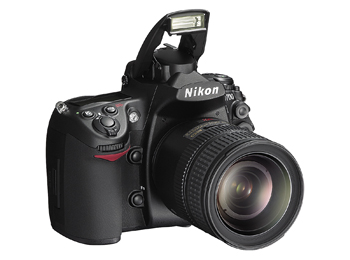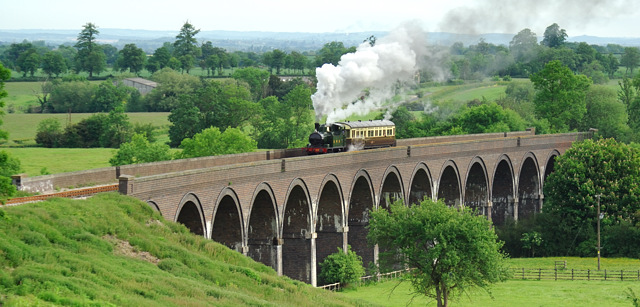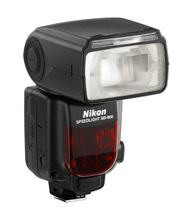Nikon D700 and SB900 Announced
|
|
|
Autocar on the Stanway Viaduct on the Gloucestershire Warwickshire Railway |
| Nikon have announced a new camera the D700, and
a new flash unit the SB900, so far we have information in specifications,
press releases and for the D700 a 24 page glossy promotional booklet. We
don't yet have access to the manuals for these. The D700 is very similar to the D300 but with a FX (35mm sized) sensor where the D300 has the DX sized sensor. The D700 has a wider ISO range, with 1 more usable stop, allowing lower light usage perhaps and extra programmable functions to the function and possibly other buttons. It also has an electronic level display to help level horizons in live view mode. Weather seals and structure are said to be more suitable for more challenging conditions as well, but as the lenses don't have the same seals its not that relevant. When the D3 came out we reported that we had seen on the Niikon Japan site that it was the first of a family of FX sensor based cameras, and the coming D3X has been widely leaked, including it mentioned in one D3 firmware update from Nikon. Its likely that the D700 will be followed by a lower priced model at some point giving a choice across two sensors formats.
I know that FX and DX don't
mean a great deal to many people, but both have advantages and
disadvantages. Each is ideal for some people, and I expect there will, like
most things photographic, and otherwise, some will like one and some
the other, in many cases without really understanding the difference, and
how it affects them. In order to try to throw some light onto this we have
produced an article FX and DX,
|
 |
 Nikon D700 - FX format like the D3 |
In doing this I have also tried to cover particularly the differences between the Nikon D300 and Nikon D700, as on the practical front, this is likely to be the choice that people are looking to choose between at this time, when looking at the differences between a FX and DX camera.
What I would like to see is a model with a smaller sensor perhaps half the size of the DX but with the same pixel count as the current DX cameras. This would allow a smaller and lighter camera, that would have greater depth of field, and both the production of smaller lenses, and existing lenses to be used as many times telephotos. Its because TV/Video cameras have smaller sensors that the wildlife filmmakers can get so much more in focus than we can with our DSLR's at long range and why they have such powerful zooms compared to what we have. I expect this will happen eventually and then we will have three formats to select from, probably the middle one the DX will remain the most popular.
The camera I am interested to see details on is the D3X, we know a little about this camera, but not the full details or when its being released, but it will be probably within the next few months. We know this will be usable as a dual format, although a bulky camera and somewhat expensive. We know it will be FX, DX and 5x4 crop, but I am particularly interested to see if it has a panorama crop as well.
|
Nikon SB900 |
Also announced by Nikon this week is the SB900 speed light. This flash unit is similar to the existing top of the range SB800, but with extended zoom, improved filter handling, and faster recycle time. It can also have its firmware updated through some cameras including the D3 and D300. Our new article
Nikon SB900 First look
We also have a page explaining the
full
range of Nikon flash units
|
Finding out more on these items:-
Handling contrast.
Using filters and filter holders.
We had said we were going to concentrate this week on looking at handling contrast, graduated filters and filter holders, following on from lasts weeks articles on photographing trains. But we didn't know then that Nikon were about to announce a new camera and flash. We have put back this now to next week to allow the information above and the article on the differences between FX and DX to be brought forward.
All prepared for August
We're into July already and although it doesn't look like it, summer theoretically is here. We have updated the photographers diary moving the July events to This Month and adding August events for Next Month. Remember to let us know about other events that you feel we should add and check from week to week as we are regularly adding extra items now.
Heritage Railway Locations
Last week we started the new railway section, and added a list of all heritage railways we are aware of, both as a long alphabetic list and also as county lists, together with links to further information on each railway. We looked at how to photograph railways and more and had location guides on some of the narrow gauge railways.
This week we are adding a number of quite detailed feature guides on a selection of standard gauge (normal size) railway lines. Plus we have one quick guide to an unusual non heritage line as the information is related to one of the heritage lines featured.
The lines we have selected are either longer, are known to have lineside passes available or we just felt were interesting. We will be producing more a few at a time, so that the coverage grows. There is more work in producing these than most other guides as we have to locate more information and we are looking at a line of locations.
This week we also start the
Featured standard gauge heritage
railways page
![]() , that
gives a quick overview of the featured heritage lines, and links to the location
guides. In many topics we have chosen to produce the list of featured sites
first and then produce details on them, while with railways we are doing it the
opposite way around, writing the location guides and then adding information on
them to the Featured standard
gauge heritage railways page
, that
gives a quick overview of the featured heritage lines, and links to the location
guides. In many topics we have chosen to produce the list of featured sites
first and then produce details on them, while with railways we are doing it the
opposite way around, writing the location guides and then adding information on
them to the Featured standard
gauge heritage railways page
![]() .
Standard gauge is what many think of as normal size, as used with mainline
trains. You can see an explanation of line gauges at the beginning of the
article on the
Great
Little
Trains of Wales.
.
Standard gauge is what many think of as normal size, as used with mainline
trains. You can see an explanation of line gauges at the beginning of the
article on the
Great
Little
Trains of Wales.
![]()
Some of the lines that don't have lineside permits we will get some quick guides added to start and perhaps add more detailed featured guides later.
Although you will find these location guides are quite large, this is only the first stage with railways. What we would like to do is to produce, for at least some lines, a full photographers guide showing locations along the line, what sort of shot you can get from different points and how to get each of them. I know the Gloucestershire and Warwickshire railway well enough to produce this now, and both the West Somerset Railway and Severn Valley Railway I have photographed on enough times to have some ideas of where to start. Over the summer I want to get out and visit far more, so I will then both be able to add more information and photos to location guides, produce more and start some of the more detailed guides. Of course I also have the windmills, and a long list of other featured topics we are working on to try to fit in as well.
Locations Guides Added This Week
The heritage Railway locations we have detailed this week are:-
Gloucestershire Warwickshire Railway,
Toddington Glos
![]()
![]()
Severn Valley
Railway, Kidderminster to Bridgnorth
![]()
![]()
Bluebell Railway, Sussex
![]()
![]()
Dean Forest
Railway, Lydney, Gloucestershire
![]()
![]()
Updated in Photographers Diary section.

